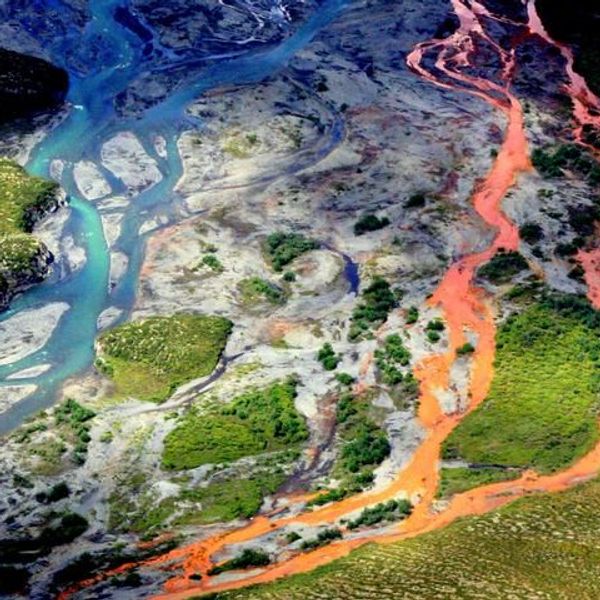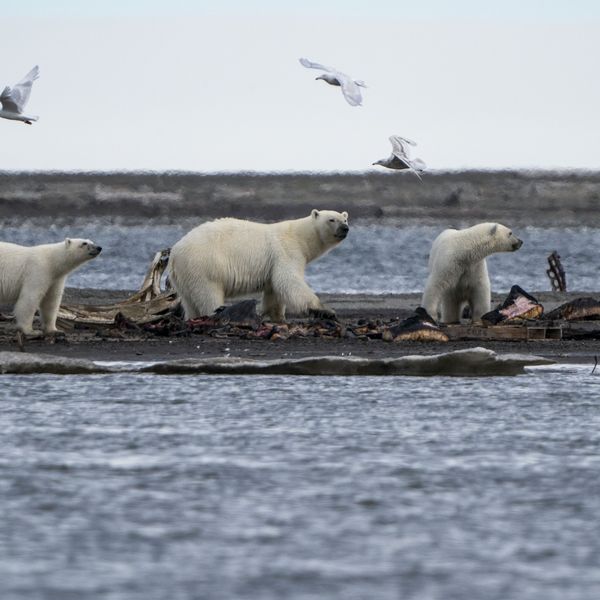Untouchable: The Climate Case Against Arctic Drilling
When you think of the Arctic, you may picture vast glaciers, frigid waters, miles of ice, and probably the quintessential polar bear. For centuries, the Arctic has been the final frontier, the end of the earth.
But a new reality is setting in in the region - a reality of a changing climate and the scramble of Big Oil to move in where sea ice is disappearing. But this irony is just the beginning. Royal Dutch Shell is leading the charge in the Alaskan Offshore Arctic, investing billions in a high-risk bet that the world will fail to tackle climate change.
In a new report we published Thursday with Greenpeace USA, we lay bare the case for why the future of Arctic oil is inherently tied to action on climate change. The bottom line is that there is no room for Arctic oil in a climate-safe world.
Here are the key reasons why:
- Fossil fuels that have not yet been proven are not burnable in a climate-safe world, given that the vast majority of the fossil fuels we already have access to will need to be left in the ground.
- Industry and government claims that Arctic oil is "needed" are based on oil supply and demand scenarios that will lead to at least 5 degrees Celsius warming by 2100 - i.e., climate disaster.
- The Obama Administration relies on this disastrous scenario as its Reference Case for long-term U.S. oil supply and demand planning. Under this scenario, U.S. CO2 emissions would be 190 percent higher than 'safe' climate levels in 2040.
- Large investments in Arctic oil are a multi-billion dollar bet that the world will fail to address climate change, and continue hazardous levels of oil use, for decades to come.
- From an investor perspective, U.S. Arctic oil is an asset that risks becoming stranded as billions are poured into exploration for a resource that cannot be safely burned.
- U.S. Arctic oil will be exposed to increasing risks associated with mounting public opposition. These public accountability risks cost other high-carbon industries, such as the Alberta tar sands, billions of dollars and are the most significant barrier to expanding fossil fuel infrastructure. Concerned citizens are increasingly willing to step up where governments and markets fail to protect the climate, the environment, and impacted communities.
The fossil fuel industry wants us to believe that oil, gas, and coal will continue to dominate our energy supply for decades to come. This fatalism is far from reality, yet it is the basis for flawed policy worldwide and justifies ongoing exploration. It is time to align energy policy with climate science and start planning for the energy transition everyone knows we must make to meet our collective climate goals.
By allowing Shell to drill in the U.S. offshore Arctic Ocean, the Obama Administration is ignoring the world's best scientists and millions of concerned citizens in North America and beyond. The message is clear: the melting Arctic is a dire warning, not an invitation.
Don't miss the new report: Untouchable: The Climate Case Against Arctic Drilling.
An Urgent Message From Our Co-Founder
Dear Common Dreams reader, The U.S. is on a fast track to authoritarianism like nothing I've ever seen. Meanwhile, corporate news outlets are utterly capitulating to Trump, twisting their coverage to avoid drawing his ire while lining up to stuff cash in his pockets. That's why I believe that Common Dreams is doing the best and most consequential reporting that we've ever done. Our small but mighty team is a progressive reporting powerhouse, covering the news every day that the corporate media never will. Our mission has always been simple: To inform. To inspire. And to ignite change for the common good. Now here's the key piece that I want all our readers to understand: None of this would be possible without your financial support. That's not just some fundraising cliche. It's the absolute and literal truth. We don't accept corporate advertising and never will. We don't have a paywall because we don't think people should be blocked from critical news based on their ability to pay. Everything we do is funded by the donations of readers like you. Will you donate now to help power the nonprofit, independent reporting of Common Dreams? Thank you for being a vital member of our community. Together, we can keep independent journalism alive when it’s needed most. - Craig Brown, Co-founder |
When you think of the Arctic, you may picture vast glaciers, frigid waters, miles of ice, and probably the quintessential polar bear. For centuries, the Arctic has been the final frontier, the end of the earth.
But a new reality is setting in in the region - a reality of a changing climate and the scramble of Big Oil to move in where sea ice is disappearing. But this irony is just the beginning. Royal Dutch Shell is leading the charge in the Alaskan Offshore Arctic, investing billions in a high-risk bet that the world will fail to tackle climate change.
In a new report we published Thursday with Greenpeace USA, we lay bare the case for why the future of Arctic oil is inherently tied to action on climate change. The bottom line is that there is no room for Arctic oil in a climate-safe world.
Here are the key reasons why:
- Fossil fuels that have not yet been proven are not burnable in a climate-safe world, given that the vast majority of the fossil fuels we already have access to will need to be left in the ground.
- Industry and government claims that Arctic oil is "needed" are based on oil supply and demand scenarios that will lead to at least 5 degrees Celsius warming by 2100 - i.e., climate disaster.
- The Obama Administration relies on this disastrous scenario as its Reference Case for long-term U.S. oil supply and demand planning. Under this scenario, U.S. CO2 emissions would be 190 percent higher than 'safe' climate levels in 2040.
- Large investments in Arctic oil are a multi-billion dollar bet that the world will fail to address climate change, and continue hazardous levels of oil use, for decades to come.
- From an investor perspective, U.S. Arctic oil is an asset that risks becoming stranded as billions are poured into exploration for a resource that cannot be safely burned.
- U.S. Arctic oil will be exposed to increasing risks associated with mounting public opposition. These public accountability risks cost other high-carbon industries, such as the Alberta tar sands, billions of dollars and are the most significant barrier to expanding fossil fuel infrastructure. Concerned citizens are increasingly willing to step up where governments and markets fail to protect the climate, the environment, and impacted communities.
The fossil fuel industry wants us to believe that oil, gas, and coal will continue to dominate our energy supply for decades to come. This fatalism is far from reality, yet it is the basis for flawed policy worldwide and justifies ongoing exploration. It is time to align energy policy with climate science and start planning for the energy transition everyone knows we must make to meet our collective climate goals.
By allowing Shell to drill in the U.S. offshore Arctic Ocean, the Obama Administration is ignoring the world's best scientists and millions of concerned citizens in North America and beyond. The message is clear: the melting Arctic is a dire warning, not an invitation.
Don't miss the new report: Untouchable: The Climate Case Against Arctic Drilling.
When you think of the Arctic, you may picture vast glaciers, frigid waters, miles of ice, and probably the quintessential polar bear. For centuries, the Arctic has been the final frontier, the end of the earth.
But a new reality is setting in in the region - a reality of a changing climate and the scramble of Big Oil to move in where sea ice is disappearing. But this irony is just the beginning. Royal Dutch Shell is leading the charge in the Alaskan Offshore Arctic, investing billions in a high-risk bet that the world will fail to tackle climate change.
In a new report we published Thursday with Greenpeace USA, we lay bare the case for why the future of Arctic oil is inherently tied to action on climate change. The bottom line is that there is no room for Arctic oil in a climate-safe world.
Here are the key reasons why:
- Fossil fuels that have not yet been proven are not burnable in a climate-safe world, given that the vast majority of the fossil fuels we already have access to will need to be left in the ground.
- Industry and government claims that Arctic oil is "needed" are based on oil supply and demand scenarios that will lead to at least 5 degrees Celsius warming by 2100 - i.e., climate disaster.
- The Obama Administration relies on this disastrous scenario as its Reference Case for long-term U.S. oil supply and demand planning. Under this scenario, U.S. CO2 emissions would be 190 percent higher than 'safe' climate levels in 2040.
- Large investments in Arctic oil are a multi-billion dollar bet that the world will fail to address climate change, and continue hazardous levels of oil use, for decades to come.
- From an investor perspective, U.S. Arctic oil is an asset that risks becoming stranded as billions are poured into exploration for a resource that cannot be safely burned.
- U.S. Arctic oil will be exposed to increasing risks associated with mounting public opposition. These public accountability risks cost other high-carbon industries, such as the Alberta tar sands, billions of dollars and are the most significant barrier to expanding fossil fuel infrastructure. Concerned citizens are increasingly willing to step up where governments and markets fail to protect the climate, the environment, and impacted communities.
The fossil fuel industry wants us to believe that oil, gas, and coal will continue to dominate our energy supply for decades to come. This fatalism is far from reality, yet it is the basis for flawed policy worldwide and justifies ongoing exploration. It is time to align energy policy with climate science and start planning for the energy transition everyone knows we must make to meet our collective climate goals.
By allowing Shell to drill in the U.S. offshore Arctic Ocean, the Obama Administration is ignoring the world's best scientists and millions of concerned citizens in North America and beyond. The message is clear: the melting Arctic is a dire warning, not an invitation.
Don't miss the new report: Untouchable: The Climate Case Against Arctic Drilling.

